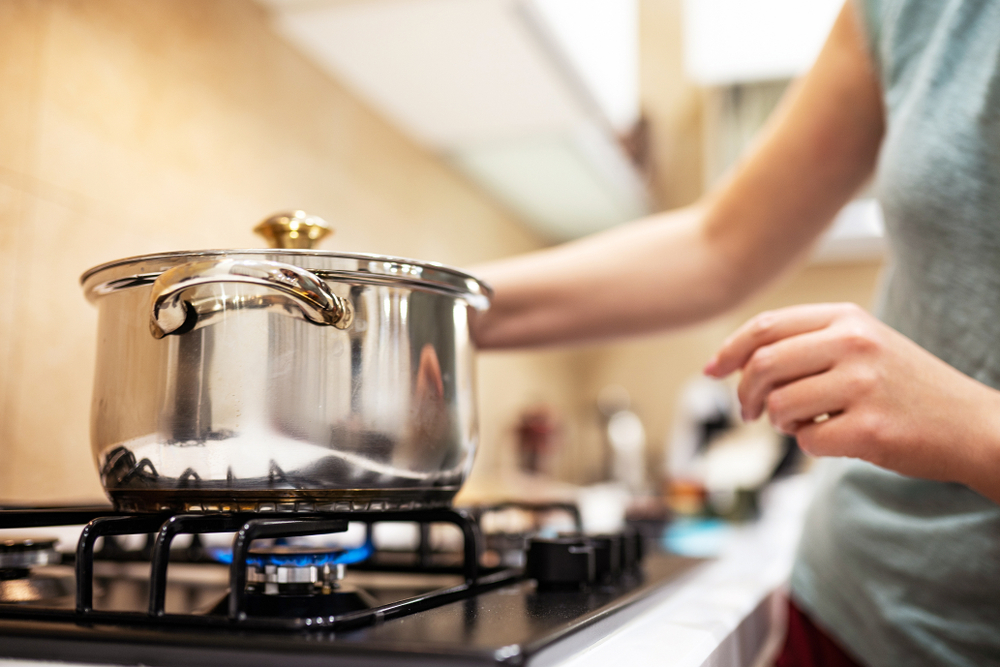In the debate over gas vs electric stoves, things can get pretty heated. There are diehard loyalists on both sides who would never dream of switching. Most of us, however, are on the fence.
This article is for those people—the ones who never really thought much about it until their stove broke and they had to start shopping for a replacement, and those who just moved into their new home and now have to fill it with appliances. We’ll cover the major pros and cons of both types and then give you some simple tips to help you decide which one makes the most sense for your home.
The Benefits of a Gas Stove

Gas stoves are favored among cooks and budget-conscious shoppers alike for their versatility and low maintenance costs. Here are some of the key benefits of a gas stove:
Better Temperature Control
Changing the temperature on a gas stove is instantaneous. You can literally watch the flame go higher or lower. You can also make minor adjustments and easily change the temperature throughout the cooking process.
This is important when cooking more delicate recipes like, say, a cheese sauce, where letting the milk boil will curdle it but letting it drop to low will prevent the cheese from dissolving properly. Even on less delicate dishes, this kind of control just makes it easier to avoid both burning and undercooking your food.
Less Expensive
While high-end gas and electric stoves are about the same price, the ongoing maintenance costs are still lower for gas stoves. Moreover, for those on a budget, it’s easier to find a reliable gas stove at the low-end of the spectrum than it is to find a reliable electric stove at that same price point.
In other words, if the cost is your main concern, you get more bang for your buck with a cheap gas stove as opposed to a cheap electric stove.
Compatible With Any Pot or Pan
For cooks with a wide array of woks, crepe pans, griddles, and other odd-shaped or uneven cookware, a gas stove is your best friend. Because heat from the flame radiates out more widely, gas stoves are better at evenly heating the entire surface area.
An electric stove will mainly heat the area sitting right on top of the heating element. If you’re trying to stir fry on an electric stove, you’ll have even more trouble as nothing heats well once you lift the pan above the heating elements.
Pro Tip: If you do opt for electric and want to use a wok or other odd-shaped pan, preheat it in the oven before you start cooking to ensure you have an evenly heated surface. Just remember to use an oven mitt when handling it!
The Drawbacks of a Gas Stove
As great as they are for cooking up elaborate recipes in your kitchen, gas stoves do have some important drawbacks to consider.
Your Home May Not Have a Gas Line
While most homes in the cities and suburbs have a gas line, more remote towns don’t always have that option. In which case, a gas stove won’t do you much good. So double-check what kind of hookups are available in your kitchen before you finalize that purchase!
Your Kitchen Will Get Hotter
When you light a gas stove, about 40% of the heat generated will transfer to your food. The other 60% will radiate out into the kitchen. If you’re in a colder climate, this room heating effect will be hardly noticeable or even pleasant for most of the year.
If you’re in a hot climate, on the other hand, you’ll be sweating bullets every time you light up the stove to fry some eggs—and don’t even think about turning that oven on in the summer!
With an electric stove, the heat is a little more concentrated. Since the pan is sitting directly on the heated coils, less heat escapes. So about 74% of heat generated transfers to the food, and only 26% leaks out into the air. That means you’ll be able to use your stove during the summer without turning your kitchen into a sauna.
Gas Stoves Can Be Tricky to Turn On
While it’s great for quick adjustments and instant temperature control once you get the burner lit, gas stoves can be a little tricky to turn on. Sometimes, the pilot light goes out. Sometimes, it tries over and over to light, but nothing happens.
You can always keep a lighter on hand in your kitchen to light a stubborn burner in a pinch. However, if you’d rather just not deal with that inconvenience, an electric stove is much less finicky about turning on.
The Benefits of an Electric Stove

While gas stoves are more affordable and better for precision temperature control, electric stoves still have a lot to offer. Here are some of the key benefits of an electric stove.
Electric Stoves Are Often Safer
Gas stoves are, unsurprisingly, a bit of a fire hazard. With that open flame, the chance of stray dishtowels or recipe books catching fire is a risk. Electric stoves don’t have this problem. The risk isn’t zero, but it’s much lower.
The risk is zero for gas leaks, however. This is a major pro for all safety-conscious shoppers but especially beneficial for homes with small children. If a curious toddler turns the knob on a gas stove, they might let gas out without anybody realizing it. If they turn the knob on an electric stove, they should be safe as long as they can’t reach the stovetop.
Cleaning Electric Stoves Is Easier
Depending on which model you get, electric stoves are a little easier to clean than their gas counterparts. The newer versions with the smooth cooktop surface are as easy to wipe down as your countertops.
The ones with electric coils are a little more involved but still easy to keep clean. For more information on how to clean electric or gas stove burners, read our guide here.
Electric Stoves Are Easier to Use
For basic cooking, where you’re using the same temperature most of the time, an electric stove is very reliable and super easy to use. Once you get a feel for what the different temperature settings do, it’ll be easy to figure out which setting will cook your pancakes without scorching them and which one simmers your rice to perfection without a single stuck grain on the bottom.
Then, you can just turn the knob to that setting and forget about it. That means no more fiddling with a stubborn pilot or accidentally nudging the knob and raising the temperature just enough to ruin your risotto.
They Could Be More Eco-Friendly
Gas stoves rely on—you guessed it—gas as a fuel source, which means that an electric stove has the potential to be a more environmentally friendly option. Electricity can be generated by clean sources like solar panels, wind turbines, hydro plants, and any other renewable alternative.
Eco-conscious consumers should be aware, however, that even if your household has gone fully electric, you may still be depending on fossil fuels. Depending on the power plant you’re connected to, that electricity might be generated by burning fossil fuels.
So, if you’re going electric in an effort to go green, check your local power supply to find out how that electricity is being made. Many power plants burn fossil fuels to generate electricity. You can search this map of US power plants to find out where your electricity comes from.
If it’s not a sustainable plant, you could buy solar panels to minimize or eliminate your dependence on the grid. If solar panels are out of your price range, a gas stove powered by natural gas may actually be cleaner than an electric stove powered by coal or oil.
The Drawbacks of an Electric Stove
The major drawbacks of electric stoves include the following.
Electric Stoves Are More Expensive
While the price range across gas and electric stoves is about the same, the quality difference is substantial. A $500 gas stove will usually be more reliable than a $500 electric stove. So, for those on a budget, getting an electric stove worth having is going to set you back.
Then, once you’ve got your electric stove, ongoing expenses are higher as well. The cost of electricity is almost always higher than the cost of gas—unless you’ve got solar panels, of course.
Temperatures Are Imprecise
As mentioned earlier, gas stoves allow you to change the temperature immediately and adjust to precise levels. With electric stoves, you don’t have a say in what the different temperature settings are. More to the point, when you switch from, say, “high” to “medium-low,” it will take a bit for the heating elements to actually cool to that temperature.
This delay can be a problem with more delicate sauces or recipes that require immediate adjustments between temperatures. Of course, that level of precision won’t really matter unless you’re an avid cook. If all you’re doing is boiling pasta or reheating beans, you’ll do just fine with your electric stove.
Cook Times Are Longer
Another drawback of having your pan sit directly on top of the heating elements (instead of resting just above a flame) is that it takes longer to heat the pan up. Those areas sitting on top of the heating elements will heat quickly, but it takes longer for that heat to spread through the full surface area.
Because of this, you have to wait longer for your pan to heat up, or else risk serving a dish that is burnt in some spots and cold in others. It also takes longer for food to cook through since the heat doesn’t radiate quite as well.
With “set it and forget it” dishes like simmering a stew or cooking beans from scratch, you probably won’t really notice the extra few minutes added to the cooking time. But when you’re impatiently waiting to scramble some eggs or boil water for a quick mac n cheese lunch, you’ll feel those added minutes stretching.
How to Choose the Right Stove for You
If reading through the pros and cons of each option has left you feeling confused about which one to choose, check out the extra tips below. Use this as a quick reference to better gauge which one might be best for you.
Get a Gas Stove If:
- You cook a lot and need full control over the heating level.
- You want to maximize a tight budget. Cheap gas stoves are generally higher quality than cheap electric stoves.
- You live somewhere with access to a gas line and gas is cheaper than electricity.
- You experiment with new recipes and techniques that require versatile cooking tools.
- You have a variety of cookware (like woks and griddles) that are tough to heat evenly.
- You grew up with a gas stove and that’s what you’re comfortable with.
Get an Electric Stove If:
- You live in a remote area with no access to a gas line.
- You prioritize eco-friendly appliances and want to reduce your dependence on nonrenewable fuel.
- You have small, curious children in your home.
- You can afford to invest in a mid-range or high-end electric stove.
- You tend to stick to a set rotation of recipes that don’t require a versatile stovetop.
- You live in a hot climate where the added heat of a gas stove would make your kitchen unbearable.
- You grew up with an electric stove and that’s what you’re comfortable with.
Things Are Heating Up
For home cooks who tend to stick to the same menu, it’ll be easier to adapt to cooking them on an electric stove. For those who experiment with new techniques and ingredients, the versatility of a gas stove is usually a must.
However, your decision will largely come down to what kind of connections your house has available and what you’re most comfortable cooking on. While there are some important differences between the two, you’ll be able to achieve just about any dish on either type once you get used to its quirks.
